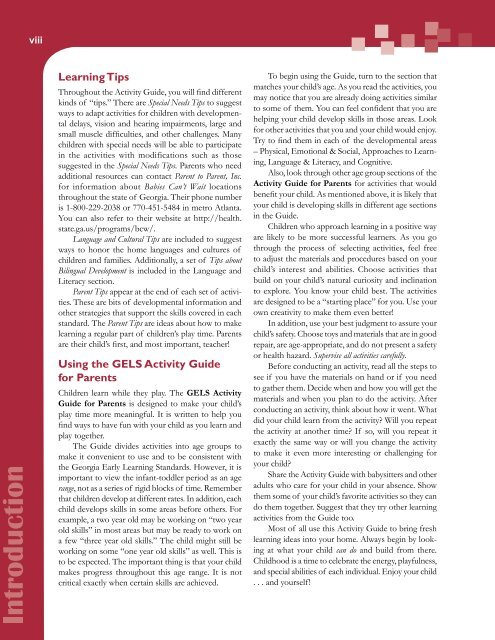Acknowledgements - gapitc
Acknowledgements - gapitc
Acknowledgements - gapitc
You also want an ePaper? Increase the reach of your titles
YUMPU automatically turns print PDFs into web optimized ePapers that Google loves.
v<br />
Learning Tips<br />
Throughout the Activity Guide, you will find different<br />
kinds of “tips.” There are Special Needs Tips to suggest<br />
ways to adapt activities for children with developmental<br />
delays, vision and hearing impairments, large and<br />
small muscle difficulties, and other challenges. Many<br />
children with special needs will be able to participate<br />
in the activities with modifications such as those<br />
suggested in the Special Needs Tips. Parents who need<br />
additional resources can contact Parent to Parent, Inc.<br />
for information about Babies Can’t Wait locations<br />
throughout the state of Georgia. Their phone number<br />
is 1-800-229-2038 or 770-451-5484 in metro Atlanta.<br />
You can also refer to their website at http://health.<br />
state.ga.us/programs/bcw/.<br />
Language and Cultural Tips are included to suggest<br />
ways to honor the home languages and cultures of<br />
children and families. Additionally, a set of Tips about<br />
Bilingual Development is included in the Language and<br />
Literacy section.<br />
Parent Tips appear at the end of each set of activities.<br />
These are bits of developmental information and<br />
other strategies that support the skills covered in each<br />
standard. The Parent Tips are ideas about how to make<br />
learning a regular part of children’s play time. Parents<br />
are their child’s first, and most important, teacher!<br />
Using the GELS Activity Guide<br />
for Parents<br />
Children learn while they play. The GELS Activity<br />
Guide for Parents is designed to make your child’s<br />
play time more meaningful. It is written to help you<br />
find ways to have fun with your child as you learn and<br />
play together.<br />
The Guide divides activities into age groups to<br />
make it convenient to use and to be consistent with<br />
the Georgia Early Learning Standards. However, it is<br />
important to view the infant-toddler period as an age<br />
range, not as a series of rigid blocks of time. Remember<br />
that children develop at different rates. In addition, each<br />
child develops skills in some areas before others. For<br />
example, a two year old may be working on “two year<br />
old skills” in most areas but may be ready to work on<br />
a few “three year old skills.” The child might still be<br />
working on some “one year old skills” as well. This is<br />
to be expected. The important thing is that your child<br />
makes progress throughout this age range. It is not<br />
critical exactly when certain skills are achieved.<br />
To begin using the Guide, turn to the section that<br />
matches your child’s age. As you read the activities, you<br />
may notice that you are already doing activities similar<br />
to some of them. You can feel confident that you are<br />
helping your child develop skills in those areas. Look<br />
for other activities that you and your child would enjoy.<br />
Try to find them in each of the developmental areas<br />
– Physical, Emotional & Social, Approaches to Learning,<br />
Language & Literacy, and Cognitive.<br />
Also, look through other age group sections of the<br />
Activity Guide for Parents for activities that would<br />
benefit your child. As mentioned above, it is likely that<br />
your child is developing skills in different age sections<br />
in the Guide.<br />
Children who approach learning in a positive way<br />
are likely to be more successful learners. As you go<br />
through the process of selecting activities, feel free<br />
to adjust the materials and procedures based on your<br />
child’s interest and abilities. Choose activities that<br />
build on your child’s natural curiosity and inclination<br />
to explore. You know your child best. The activities<br />
are designed to be a “starting place” for you. Use your<br />
own creativity to make them even better!<br />
In addition, use your best judgment to assure your<br />
child’s safety. Choose toys and materials that are in good<br />
repair, are age-appropriate, and do not present a safety<br />
or health hazard. Supervise all activities carefully.<br />
Before conducting an activity, read all the steps to<br />
see if you have the materials on hand or if you need<br />
to gather them. Decide when and how you will get the<br />
materials and when you plan to do the activity. After<br />
conducting an activity, think about how it went. What<br />
did your child learn from the activity? Will you repeat<br />
the activity at another time? If so, will you repeat it<br />
exactly the same way or will you change the activity<br />
to make it even more interesting or challenging for<br />
your child?<br />
Share the Activity Guide with babysitters and other<br />
adults who care for your child in your absence. Show<br />
them some of your child’s favorite activities so they can<br />
do them together. Suggest that they try other learning<br />
activities from the Guide too.<br />
Most of all use this Activity Guide to bring fresh<br />
learning ideas into your home. Always begin by looking<br />
at what your child can do and build from there.<br />
Childhood is a time to celebrate the energy, playfulness,<br />
and special abilities of each individual. Enjoy your child<br />
. . . and yourself!
















